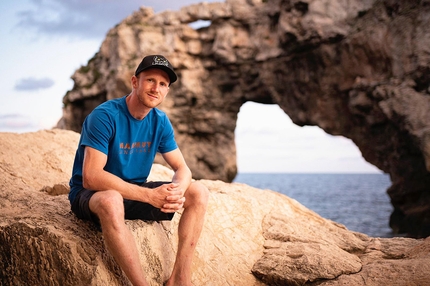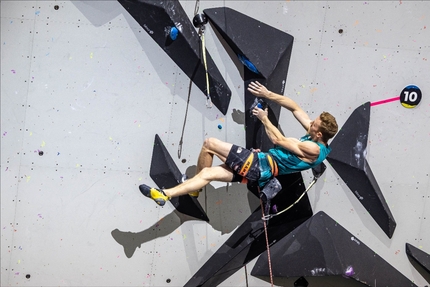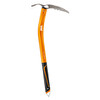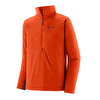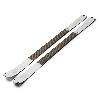Jakob Schubert proposes 9c for B.I.G. at Flatanger

 1 / 7
1 / 7 Moritz Klee / Nodum Sports
Moritz Klee / Nodum Sports
Jakob Schubert is one of the most successful sport climbers of our times. Equally at home in competitions as at the crag, the 32-year-old Austrian is a staggering four times Lead World Champion and three times Lead World Cup winner who in the past has redpointed up to 9b+.
On 20 September Schubert took his climbing to the next level at Flatanger in Norway with the first ascent of Project Big, the 'true king line of the cave' according to Adam Ondra who bolted the route in 2013 prior to establishing Silence, the world's first 9c. Schubert has now called the line B.I.G. and, after careful consideration, has suggested 9c, making it only the third route in world with this grade after the aforementioned Silence and DNA put up by Seb Bouin in the Verdon Gorge. All three await confirmation.
Schubert's outstanding first ascent is interesting because not only was it "the biggest mental battle I've ever had in my career", but also because it marks, for the first time, the moment when he finally channeled all his talent, skill and patience into one single route that had never been climbed before. Here are the details.
Jakob for those who don't know Project Big, or what you have now called B.I.G, can you quickly describe it?
I'd say it's one of, if not the, best lines in the Flatanger cave. Basically it climbs its way straight out of the cave. Adam Ondra bolted it along with Silence over a decade ago and at the time he had these two projects on the go, Project Hard which became Silence, and Project Big. Big obviously refers to the fact that it's such a huge, crazy line. It splits into roughly four sections I'd say. The first 20m traverse is about 7a, and before topping out you leave this route to enter new terrain. Here there's a 8A/8A+ boulder problem that leads into a big dihedral with kneebar rests; this section would probably be about 8c, perhaps something a bit harder. From this rest there are 20 moves of really consistent, hard climbing, with a boulder right at the beginning and a powerful crux at the end. These 20 moves in their own right would be a hard 9b I reckon. And from here you enter the 4th section, a pumpy 8a, 8a+ route. We reckon if you're up there you won't fall, but actually if you're completely pumped, it's not easy to keep it all together.
Apart from being damn hard, what's the climbing like?
It's not just hard, it's also very, very beautiful. It's an amazing climb, it has some of the coolest holds I've ever seen and it's really skin-friendly. And the crux moves are just so much fun! So it's not just one of the hardest routes, it's definitely also one of the best.
How long did it take you?
I tried the route basically for a full month last year. This year I was prepared for another 3 weeks but luckily I did it after 2! So 6 weeks in total.
How many attempts per day were you managing? Were you still learning much or were you 100% efficient?
This is what made Project Big so hard mentally, because I felt like I only ever had one good try per day. When it was sunny the sun reached the cave at 14.00 which made a second try almost impossibile, because after a first try I always needed a really long rest. This route isn't just pumpy and tiring on my forearms, but it's also really draining for the rest of the body. The kneebars and rests are all quite powerful and draining. So I was going for one good try a day. Towards the end I wasn't learning much, I felt I'd optimised everything perfectly. The only thing I never really knew was how much time to spend at the rests, that seemed to vary from try to try, sometimes I wanted to rest my legs more than my forearms, other times the opposite. It was difficult to figure out how to be 100% efficient.
In the run-up, just before your actual send, you got really really close!
Actually I had a couple of really good tries this trip, one in particular I remember a crazy fight when I fell where it's supposed to get easier. But the problem is I was just way too pumped. On other occasions I felt way better, much stronger, but for various reasons I fell on the crux. I knew all I needed was a bit of luck and good conditions.
Ah, Flatanger conditions...
Yeah they changed a lot! During the first two days we experienced perhaps the best conditions I've ever seen in Flatanger. We had one day last year that was similar, so I was kind of nervous and hoped we'd get more days like those, but unfortunately they didn't materialise. That's why I started making proper redpoint attempts almost immediately, on my 4th day this trip actually, and I got really close. But perhaps on that occasion I wasn't in the right frame of mind. Conditions were OK during my livestreams, and then it rained continually for 2 days so I got worried, also because it seemed foggy. This is actually the worst because everything gets very humid very fast. On my send day I wasn't even sure if we'd go climbing, it had rained incessantly for 20 hours. In the end though things turned out perfectly!
You mentioned the livestream! How was that? Did it make things perhaps even harder?
It was definitely a fun experience and I'm really happy how the community reacted, how many people tuned in to watch. Afterwards I'd read all the comments and see the support I was getting, it gave me a lot of energy and I’m grateful for their support. I think on my first live try I was a bit nervous, I wanted to make a good attempt and show people that I actually stood a good chance, but as I climbed higher and higher I completely forgot that there was a camera and people watching. I was in full focus and couldn't think about anything else. You know, falling, failing, is also part of the process and something I feel others might want to see. I wanted to show people the raw footage, how things really are when trying a hard route. As to your question, now that I think of it, perhaps there was that tiny bit of extra pressure because I really wanted to share the send with others, and luckily I did!
How do you feel now?
Obviously it feels just amazing to have finally sent Project Big. It took a while and it was certainly a huge mental battle, but the day of the send was just amazing. It started raining the next day and the entire cave became wet, so now I'm even happier because I feel like I managed to grab my last chance this season.
Talking about grabbing... on the send go a massive hold broke just below the top and you almost fell!
That hold break was just insane! I've held that jug quite a few times in the past and I'd noticed that it had a little crack, but I'd not given it too much thought. The fact that it broke on my send go was insane, I was in the air with my left arm and I got really close to falling. I can't even imagine what it would have done to me mentally, falling there and then perhaps not being able to try the route again due to bad conditions. I'm just so happy it worked my way and now this is nothing more than a cool story!
Why this route Jakob? Why not others?
This is definitely the longest project I've had. Project Big is basically the first route I've projected and not been able to do on my first trip, there's no other line I've invested so much time and thought into. Obviously there are loads of others I'd love to try but I'm kind of ambitious and when I set myself a goal I like to see it through. Especially if I feel I can do it, but haven't. One of my main goals this season was to finish this route and that's why I never gave up. It was an amazing process, I learnt a lot.
Last question Jakob, you've previously climbed a bunch of 9b's, one 9b+. Tell us about the grade here
When Adam and I started trying this route last year, I initially thought it could very easily be 9c, but after making a lot of progress very quickly and feeling pretty close on it after 2 weeks already, Adam and me both were pretty confident it’ll be 9b+. But somehow we tried a lot more and didn’t make much progress and in hindsight I don’t even think we were actually that close, because we were mostly struggling to stick the crux move and believed to be in for the send once that happens. Knowing how my attempts unfolded this season puts things into a different perspective, as I stuck that move four times without sending.
My reference for 9b+ is Perfecto Mundo which I sent in about 3 weeks of work and which felt way easier to me than B.I.G. The only other guy who tried B.I.G. a lot is Adam and I’m happy he shared all his opinions with me which definitely helped me draw my conclusions.
I felt at a point where I had found the most efficient way possible for me, the whole route was worked out perfectly and I didn’t see any room for improvement. So all that it came down to was my physical & mental shape which I think are very good right now. Given the current information that I have and considering Adam’s opinion, it feels right to propose 9c and I’m looking forward to see what time will tell. The one thing I know for sure is that it will always be one of my most memorable ascents.
JAKOB SCHUBERT 9B OR HARDER
2014 - Fight or flight (9b) - Oliana (ESP) - repeat
2016 - La Planta da Shiva (9b) – Villanueva del Rosario (ESP) - repeat
2018 - Stoking the Fire (9b) – Santa Linya (ESP) - repeat
2018 - El Bon Combat (9b) – Cova de I'Ocell (ESP) - repeat
2018 - Neanderthal (9b) – Santa Linya (ESP) - repeat
2019 - Perfecto Mundo (9b+) - Margalef (ESP) - repeat
2021 - King Capella (9b) - Siurana (ESP) - repeat
2022 - Erebor (9b) - Arco (ITA) - repeat
2023 - Project Big (9) - Flatanger (NOR) - first ascent
Link: FB Jakob Schubert, Instagram Jakob Schubert, La Sportiva, Mammut



 Copia link
Copia link

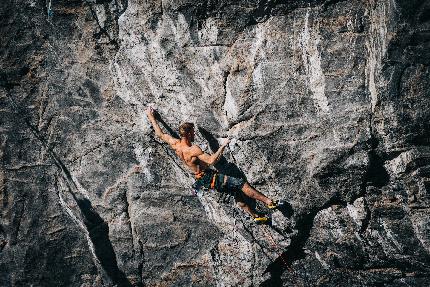
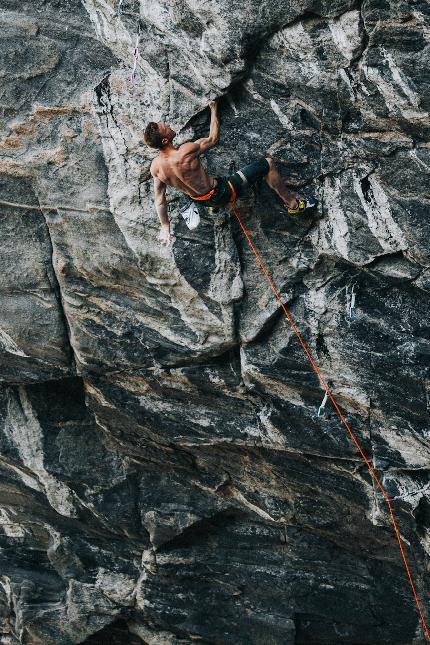




 See all photos
See all photos
